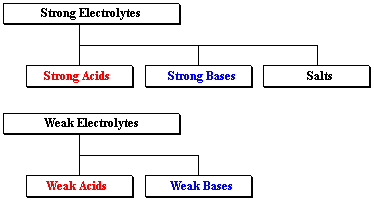Strong electrolytes fall into three categories: strong acids, strong bases, and salts. (Salts are sometimes also called ionic compounds, but really strong bases are ionic compounds as well.) The weak electrolytes include weak acids and weak bases.

Examples of strong and weak electrolytes are given below:
| Strong Electrolytes | strong acids | HCl, HBr, HI, HNO3, HClO3, HClO4, and H2SO4
| strong bases | NaOH, KOH, LiOH, Ba(OH)2, and Ca(OH)2
| salts | NaCl, KBr, MgCl2, and many, many more
| Weak Electrolytes
| weak acids | HF, HC2H3O2 (acetic acid), H2CO3 (carbonic acid), H3PO4 (phosphoric acid), and many more
| weak bases | NH3 (ammonia), C5H5N (pyridine), and several more, all containing "N"
| |
Being Able to Classify Electrolytes Is Critical
As chemists, we need to be able to look at a formula such as HCl or NaOH and quickly know which of these classifications it is in, because we need to be able to know what we are working with (ions or compounds) when we are working with chemicals. We need to know, for example, that a bottle labeled "NaCN" (a salt) really contains no NaCN, rather Na+ and CN–, or that a bottle labeled "HCN" (a weak acid) is principally HCN with a small amount of H+ and CN– also present. The difference between just opening a bottle labeled "HCN" and one labeled "NaCN" could be your life, as HCN, or hydrogen cyanide, is a toxic gas, while CN–, or cyanide ion, being an ion, isn't a gas and is only transfered in solid or solution form. Nonetheless, it is cyanide ion, CN–, that is the killer. (It locks onto the Fe3+ in hemoglobin, causing less oxygen to get to your brain.) Cyanide is present in both bottles, and if it is transfered to your bloodstream either as CN– or as HCN, it will kill you.
Six Steps for Categorizing Electrolytes
So how do we categorize compounds based on their formula? One practical method is outlined below:
| Step 1 | Is it one of the seven strong acids? |
| Step 2 | Is it of the form Metal(OH)n? Then it's a strong base. |
| Step 3 | Is it of the form Metal(X)n? Then it's a salt. |
| Step 4 | Does it's formula start with 'H'? It's probably a weak acid. |
| Step 5 | Does it have a nitrogen atom? It may be a weak base. |
| Step 6 | None of those? Call it a nonelectrolyte. |
Note that there are ambiguities here starting in Step 4. That's just the way it is. To determine whether a substance is a weak acid or weak base you have to know more than the molecular formula, especially for compounds containing carbon. (A structural formula, which shows the detailed connections of atoms is often necessary.)
Summary
In summary, know the more common element names and symbols, memorize the seven strong acids, be able to spot a metal (know at least where they are on the periodic table), memorize at least a few of the more common weak acids and weak base, and you will be in good shape.
YOU CAN DO IT!